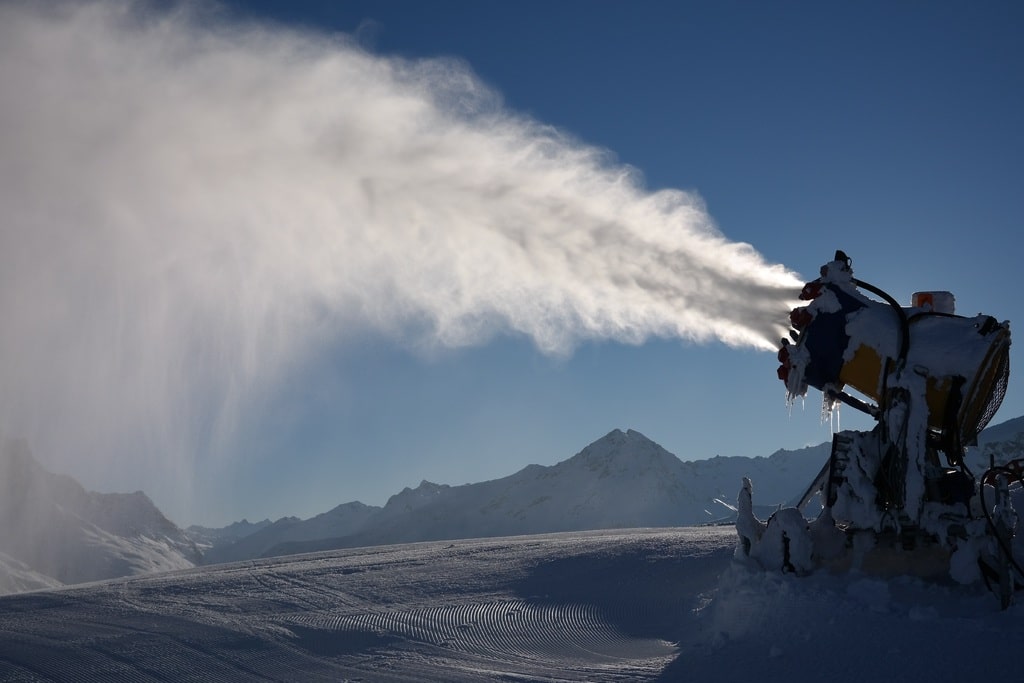Ski resorts around the world are facing unprecedented challenges due to the impacts of climate change, with rising temperatures, changing precipitation patterns, and unpredictable weather events threatening the industry. In response to these challenges, many ski resorts are implementing a variety of climate adaptation strategies to ensure their viability in a warming world.
—
1. Snowmaking
Perhaps one of the most well-known and used adaptation measures is the production of machine-made snow. With warmer temperatures leading to less natural snowfall, ski resorts are investing in snowmaking technology to ensure consistent snow cover on their slopes.
Snowmaking involves producing snow artificially by spraying water and compressed air into the atmosphere. This technology allows resorts to supplement natural snowfall and extend their skiing seasons. By investing in snowmaking infrastructure, ski resorts can reduce their reliance on natural snow and maintain their snow cover even in warmer winters. However, snowmaking can be energy-intensive and costly.
According to a 2023 study by the University of Waterloo, Canada and the University of Innsbruck, Austria investigating the energy usage associated with snowmaking in Canadian ski resorts, snowmakers utilize approximately 478,000 megawatt-hours of electricity – with 130,095 tonnes of associated carbon dioxide (CO2) emission, equivalent to the energy consumption of nearly 17,000 homes in a year – and 43.4 million cubic meters of water to produce artificial snow. It is also interesting to know that only about 75% of the water that goes into the snow guns is turned into snow, the rest either remains in the gun or is blown away without freezing.
This has pushed many resorts to look for alternative ways to make the process more sustainable. For instance, the ski resort of La Molina (Spain) is testing a new snowmaking technique that involves adding a mineral called feldspar -very abundant and efficient at triggering the freezing of water droplets- to the water used in snow guns. This is expected to allow improving the water conversion ratio up to 90% and reduce energy consumption by around 30%. .
- Pros: Increases reliability of ski season
- Cons: Requires significant energy and water usage
2. Slope Development
Another key adaptation measure that can be used at ski resorts is slope development. Many resorts are redesigning their slopes to accommodate for changing snow conditions and optimize snow retention. This may involve regrading slopes, widening trails, incorporating more trees to create shaded areas, or adding snow fences to retain snow and prevent erosion. By strategically developing their slopes, ski resorts can better manage their snow resources.
Some resort managers are developing new ski slopes located at higher altitudes. This is the case of Aspen Mountain, Keystone Resort and Steamboat Ski Resort in Colorado, US.
- Pros: Helps preparing slopes in a way that reduces the amount of required natural snow to operate
- Cons: Can be a costly investment and have potential negative impacts on the local ecosystem
3. Snow Farming
Another innovative and effective adaptation measure is so-called “snow farming”. This technique involves collecting and storing snow from previous winters in shaded areas or insulated structures to preserve it during the summer months for future use. By stockpiling snow in advance, ski resorts can ensure a reliable snow base even in warmer winters.
Snow farming can be particularly beneficial for ski resorts that experience unpredictable snowfall patterns or rely on early season snow to kick off their skiing seasons. By integrating snow farming practices into their operations, ski resorts can build resilience against climate variability, create a good snow base, and guarantee a consistent snow cover throughout the season.
The strategy is only now beginning to gain traction, with snow farming already practiced in countries such as Finland, Sweden, and Switzerland.
- Pros: Helps ensure a consistent snow base throughout the ski season, reduces reliance on machine-made snow, and allows ski resorts to extend their operating season
- Cons: Requires significant investment in equipment and infrastructure, and can be labor-intensive and time-consuming to manage the whole process
4. Improving Climate Forecasting
Accurate climate forecasting is crucial for ski resorts to anticipate and prepare for changing weather patterns. Ski resorts are investing in advanced weather monitoring technologies and partnering with meteorological agencies to improve their climate forecasting capabilities. By tracking weather trends and predicting snow conditions, ski resorts can better plan their snowmaking, grooming, and slope maintenance activities.
Real-time weather data can help resorts adjust their operations in response to sudden weather events and optimize their snow conditions for skiers. By enhancing their climate forecasting abilities, ski resorts can stay ahead of climate change impacts and adapt their operations accordingly.
- Pros: Helps making informed operational decisions more efficiently
- Cons: Advanced climate forecasting technologies are expensive and can be subject to errors and unpredictable weather events
You might also like: US Ski Industry At Risk of Collapse As Global Warming Accelerates
5. Market Diversification
As climate change impacts the ski industry, resorts are diversifying their market offerings to reduce their reliance on traditional winter tourism. Lots of ski resorts are expanding their activities beyond skiing and snowboarding to attract visitors year-round by investing in summer activities such as mountain biking, hiking, zip-lining or alpine slides. By diversifying their offerings, ski resorts can generate revenue during off-peak seasons and reduce their dependence on winter sports. Additionally, some resorts are promoting ecotourism and sustainability initiatives, such as the implementation of electric snow scooters to navigate through resorts, to attract environmentally conscious travelers.
- Pros: Reduces dependence on seasonal fluctuation and helps attracting new customers and generates additional income
- Cons: Requires significant investment in infrastructure, marketing and staff training, and too many different activities can lead to a loss of identity and brand recognition
6. Industry Consolidation and Cooperation
To address the challenges of climate change, ski resorts are collaborating with industry partners and stakeholders to implement collective adaptation measures. Resorts are forming partnerships with neighboring resorts to share resources, coordinate snowmaking efforts, and collectively market their destinations. By collaborating with other resorts, ski areas can enhance their snow management capabilities, reduce operational costs, and create a more resilient industry.
Additionally, some resorts are partnering with local communities, governments, and environmental organizations to develop sustainable tourism practices and protect their natural environments. By working together, ski resorts can strengthen their resilience to climate change and ensure the long-term sustainability of the ski industry.
- Pros: Increases efficiency and cost savings, and improves better response to climate change challenges
- Cons: Large corporations can take over local ski resorts and limit consumer choices
7. Operational Changes
Finally, ski resorts can reduce their environmental footprint and adapt to changing snow conditions by making operational changes. Some resorts are already implementing energy-efficient snowmaking equipment, optimizing grooming practices, promoting sustainable transportation options for guests and even generating renewable energy on-site. By reducing their energy consumption and carbon emissions, ski resorts can not only adapt but also minimize their contribution to climate change and mitigate its effects on their operations.
Additionally, resorts may incorporate water conservation measures, waste reduction strategies, and recycling programs to minimize their environmental impact. By adopting all these sustainable practices, they can protect the natural resources that are essential for their operations and ensure the long-term sustainability of the ski industry.
- Pros: Reduces environmental impact and helps mitigating climate change
- Cons: Requires very high initial implementation costs
Final Thoughts
Ski resorts around the world can implement a variety of measures to adapt to the impacts of climate change and ensure their viability. By investing in snowmaking technology, slope development, snow farming, climate forecasting, market diversification, industry consolidation and operational changes, ski resorts can face changing snow conditions, reduce their environmental footprint and attract visitors all year-round.
However, while these climate adaptation strategies can help ski resorts adapt to the impacts of a changing climate, it is important to remember that they are ultimately short-term solutions. Without addressing the root causes of climate change, such as reducing greenhouse gas emissions, ski resorts may ultimately face the risk of maladaptation, where well-intentioned adaptation measures inadvertently contribute to further exacerbating global warming. It is therefore crucial for ski resorts to prioritize long-term sustainability measures and work towards creating a more resilient and adaptive industry for the future.
You might also like: Snow in Peril: The Impact of Climate Change on Ski Resorts in the Pyrenees


















